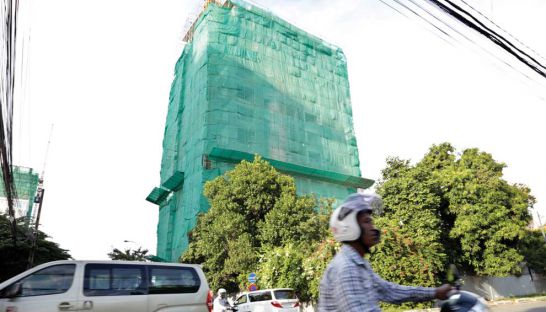With soaring prices, local developers shift away from BKK1
With soaring prices, local developers shift away from BKK1
The real estate market in the BKK1 area appears to be beginning to slow after years of accelerated growth as local investors look for more affordable alternatives within Phnom Penh.

Seng Bunna, CEO of Bunna Realty Group, said that while the history of BKK1’s foreign-oriented growth dates back to the days of UNTAC when United Nations officials, diplomats and NGOs hunkered down in low-rise villas, recent years of growth has transformed the area into a bustling commercial hub with an upscale housing market – replacing the traditional tenants with a new class of residents amidst tall buildings.
“[The] BKK1 area can be called a diverse zone. It is a region that consists of hotels, condominiums, apartments, restaurants, schools, and popular cafés. It is comparable to Sukhumvit in Bangkok.”
While he noted that there is still room in BKK1 for more growth, he has seen a trend in investors developing in BKK2 and BKK3, Toul Tom Pong and Phsar Doeum Thkov area alongside the Russian Market due to “improved infrastructure in that area.” Prices for land in these areas are 30 to 40 per cent cheaper, he said.
Kek Narin, an independent real estate investor, said as far as he has noticed, BKK1 currently has around 20 new condominium and apartment projects under construction, with at least another 50 already completed. He noted that BKK1 is still seen as the best area to live in and one that attracts tenants from around the region despite condominium prices ranging from $2,700 to $3,500 per square metre while land is selling at $5,000 to $6,000 per square metre, but “for local investors, they do not dare build a condominium in that area.”
Instead, more suitable prices in areas with the potential for long-term growth have become a safer bet for investors, he said, agreeing with Bunna about the rise of adjacent neighborhoods.
“In other areas the price of land is still reasonable, allowing for more reasonable rental agreements that will fill units,” he said. In adjacent areas, a one bedroom apartment or flat can cost around $400 to $600 a month, while the typical price in BKK1 ranges from $800 to $1,200 a month.
Chrek Soknim, CEO of Century21 Mekong, said that while BKK1’s rise of premium upscale projects will likely continue there will come a point when development will peak.
While he noted that BKK1’s growth is presently healthy “the area is getting overcrowded and it is getting tougher to find a place for more development,” he said.
One developer who has already shifted away from the prominent neighborhood is Meng Lun, CEO of LCPP Resident. He claimed that his firm has succeeded with three large condominium projects in neighborhoods outside of BKK1, selling out at 100 per cent. Resident L Cambodia, their forth condominium project located in Toul Tompong, is 65 per cent sold, he said.
“Because my condominium projects focus on middle class, we cannot develop our projects in the BKK1 area because the land in the area is very expensive which leads to high investment cost; thus, we would not be able to sell our [units],” he said.
Kim Heng, Chairman of the Cambodian Valuers and Estate Agents Association, said that BKK1 competition has reached a point where developers will continue build, but that affluent housing demand has peaked.
“Right now, it is difficult to find a land in BKK1. Even if there was, it would be difficult to find buyers, too. The average land price in this area is 3 million dollars and if a building is constructed, investors have to pay three times the land price,” he explained, adding that adjacent areas could more easily absorb increased development.
“This is a good choice because regular Cambodians cannot live in BKK1. Only rich people can afford to stay there.”













